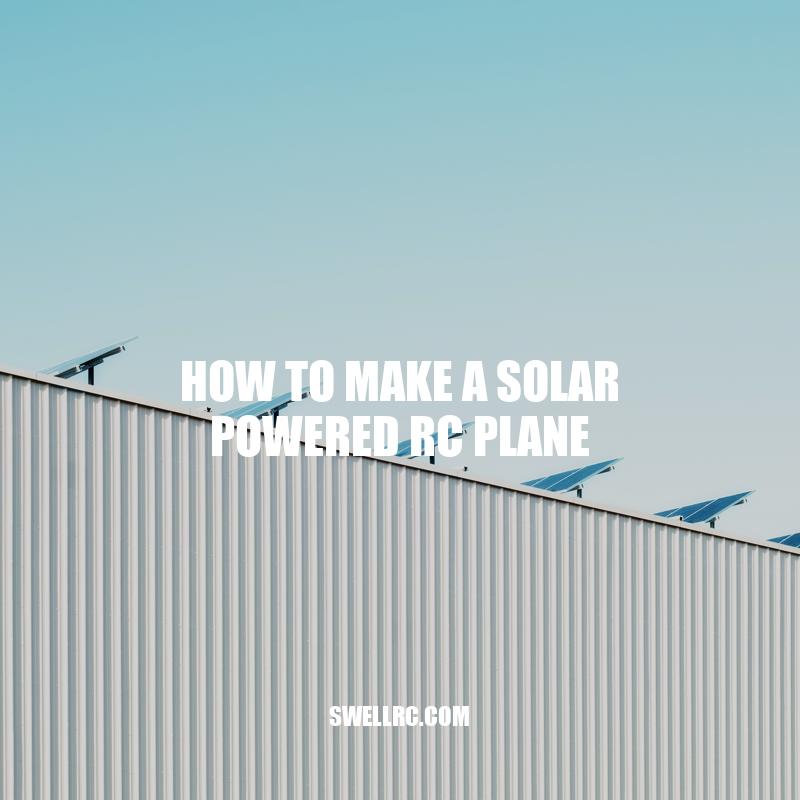How to Make a Solar-Powered RC Plane
Solar-powered RC planes are gaining popularity among hobbyists and enthusiasts in the RC (Remote Control) airplane community. These planes are not only environmentally friendly, but their ability to power up from the sun means that they can fly for longer periods without the need for recharging. Whether you’re an experienced builder or a beginner looking for a new challenge, building a solar-powered RC plane is an excellent way to learn about aerodynamics, renewable energy, and the use of DC motors. With a few basic materials and tools, you can create your own solar-powered RC plane from scratch. This project requires time, patience, and a strong commitment to detail, but the end result will be satisfying for anyone who loves DIY and RC planes. In this article, we’ll take you through the steps involved in building a solar-powered RC plane, from materials needed to testing and flying the plane. Follow these instructions, and you’ll have a unique and functional airplane that will turn heads at your next RC club gathering.
Materials Needed
Building a solar-powered RC plane requires the right materials and tools. Here are the basic materials required:
- Foam Board
- Solar Panel Material/Flexible Solar Panels
- Glue (Hot Glue Gun)
- RC Motor
- Carbon Fiber Rods
- Brushless DC Motor
- Lithium Polymer Battery
Advanced materials and tools for the project include a charge controller, a soldering iron, wire cutters, and a knife. Want to purchase any of these materials? Visit online stores such as Amazon, eBay, RCToysandDrones, or FliteTest for reliable sources.
BUILDING THE SOLAR PANELS
The first step to building a solar-powered RC plane involves building the solar panels. Here is what you need to do:
- Cut the foam board material into the required size and shape.
- Attach the solar panel materials or solar cells onto the foam board in the desired pattern(20 to 30% of the airplane surface area).
- Connect the solar panels in series, make sure they have a voltage rating that matches the motor under 7.2-9V, and install a charge controller to regulate the voltage.
It is now time to look at step 3, assembling the RC plane.
How can solar cells power an RC plane?
There are a few ways solar cells can power an RC plane:
- Solar cells can recharge the plane’s batteries while it’s not in use, extending its flying time.
- Solar cells can directly power the plane’s electric motor, converting sunlight into energy.
The amount of solar cells needed depends on the size and weight of the plane. Some RC planes are specifically designed with solar cells in mind, like the Sunbird from Voltaic Systems. It comes with its own solar panel and can fly for over an hour on a single charge.
Assembling the RC Plane
Assembling a solar-powered RC plane is a challenging and rewarding experience. Here are the materials and tools needed:
- Foam board
- Glue (Hot Glue Gun)
- Carbon Fiber Rods
- Brushless DC Motor
- Lithium Polymer Battery
- Propeller
- RC Receiver and Transmitter
- Servo (rudder and elevator control surfaces)
Here are the steps to follow in assembling your solar-powered RC plane:
| Step | Description |
|---|---|
| Step 1 | Cut the foam board material into the required size and shape using a sharp knife. |
| Step 2 | Assemble the airplane frame by gluing the pieces of foam board together. Hot glue can be used for the best effect. |
| Step 3 | Install the brushless DC motor on the front of the airplane and attach the propeller to it. |
| Step 4 | Connect the motor to the battery and the esc (electronic speed controller). |
| Step 5 | Install the elevator and rudder control surfaces on the tail of the airplane. |
| Step 6 | Install the RC receiver and servo in the fuselage. |
| Step 7 | Connect the control surfaces to the RC receiver. |
| Step 8 | Make sure everything is connected securely, balanced and aligned with the center of gravity of the airplane. Test all control surfaces and make adjustments if needed. |
Once you’re satisfied with the assembly, it’s time to test the plane. Did you know that a solar plane named Solar Impulse made the first solar-powered flight across the Atlantic on June 23, 2016? It flew a distance of 4,000 miles using only the power of the sun.
Would solar-powered planes work?
It is possible for solar-powered planes to work, but there are currently limitations.
Here are some key points to consider:
- Solar panels are less efficient at higher altitudes, where planes typically fly.
- Weight is a major factor in air travel, and the additional weight of solar panels and storage systems could be a challenge.
- Solar-powered prototypes and drones have been successful, but scaling up to commercial planes would require significant technological advancement and infrastructure.
Several companies, including Solar Impulse and SunDrive, are working on developing solar-powered planes. However, at this time, solar-powered planes are not yet a viable option for commercial air travel.
Testing the RC Plane
Before flying your solar-powered RC plane, it’s essential to test it to ensure that everything is working correctly. Here are the steps to follow:
- Connect the battery to the speed controller and check the LEDs on the motor.
- Power on the transmitter and connect it to the receiver.
- Check that all the control surfaces are moving correctly and respond to the transmitter inputs.
- Check that the motor starts up correctly and the propeller spins in the right direction.
- Check the balance of the plane and adjust the weight distribution if necessary.
Once everything is checked, you can take your plane out for a test flight.
Here are a few tips for flying your plane:
- Find a large, open space away from people and buildings.
- Always fly with another person, so there’s someone to watch the plane if you lose control.
- Start with short flights to get the hang of the controls and the handling of the plane.
- Make sure the plane is facing the wind before takeoff.
- Gradually adjust the trim controls for correct flight stability and balance.
If you have any questions about the assembly or flight of your solar-powered RC plane, there are several online communities and forums where you can share your experiences and ask for help. Websites like RC Groups, Flitetest, and Instructables offer a wealth of information, resources, and support for RC enthusiasts.
How long can a solar-powered plane fly?
A solar-powered plane can fly for several days and nights without refueling. The duration of the flight depends on factors like weather conditions, speed, altitude, and battery capacity. The current record for a solar-powered plane flight is over five days straight.
Solar planes have been designed to promote clean energy and cut down on pollution. However, their use is mostly experimental, and they are not available commercially. If you are interested in learning more about solar energy and products, various websites, such as EnergySage and SolarReviews, provide helpful insights and reviews of solar panels, inverters and other related products.
Improving the Performance of Your Solar-Powered RC Plane
If you want to improve the performance of your solar-powered RC plane, here are a few ideas to consider:
Upgrade Your Motor and Propeller
Upgrading your brushless DC motor and propeller can increase the thrust and efficiency of your plane. A more powerful motor can enable your plane to fly at higher altitudes and speeds, while a larger-diameter propeller can generate more lift and reduce drag. Make sure to match the motor and propeller to the voltage and amperage rating of your solar panels and battery.
Improve the Aerodynamics
Making adjustments to the wing and tail surfaces can improve the stability and control of your plane. Adding winglets, vortex generators, or flaps can enhance the lift and drag characteristics of your plane, while modifying the angle of incidence or elevon settings can improve the pitch and roll performance.
Optimize Solar Panel Efficiency
Using high-efficiency solar panels, such as monocrystalline or polycrystalline types, can increase the power output of your panels, allowing you to fly longer and further. Keeping your solar panels clean and free from dirt, dust, and debris can also ensure maximum exposure to sunlight and optimal energy conversion.
Join Online Communities and Forums
Finally, don’t hesitate to join online communities and forums to connect with fellow RC enthusiasts, learn new tips and tricks, and share your experiences. Websites like RCGroups, Flitetest, and Instructables offer a wealth of information, resources, and support for those interested in RC planes and DIY projects.
Are solar-powered planes possible?
Yes, solar-powered planes are possible and have already been developed and tested. Here are some key points to consider:
- The Solar Impulse 2 plane completed a nearly 26,000-mile journey around the world in 2016, powered entirely by the sun.
- The plane used about 17,000 solar cells on its wings to charge four lithium polymer batteries to store energy to fly the plane at night.
- Solar aircraft can be used for missions such as surveillance, monitoring, and atmospheric research.
To learn more about solar power and renewable energy, visit websites such as renewableenergyworld.com or solarpowerworldonline.com.
Some Precautions To Consider
While making and flying a solar-powered RC plane can be fun, there are certain precautions you should take to ensure safety and proper functioning:
Choose the Right Weather Conditions
Flying your plane in rainy, windy, or cloudy weather can affect the stability and power output of your solar panels and motor. Always check the weather forecast and fly your plane in calm and sunny conditions. Avoid flying your plane near thunderstorms, airports, or crowded areas.
Use Appropriate Safety Gear
Wearing safety gear such as goggles, gloves, and protective clothing can protect you from injury caused by the plane or propeller. Meanwhile, keeping a fire extinguisher, first-aid kit, and other emergency equipment ready can provide extra protection during any accidents.
Comply with Laws and Regulations
Before flying your solar-powered RC plane in public areas, ensure that you comply with local, state, and federal laws and regulations. You might require permits, certifications, or special licenses to fly your plane in certain areas or conditions. Check with the local authorities and aviation officials about any restrictions, prohibited zones, or airspace rules.
Regular Maintenance and Inspection
Regularly checking and maintaining the components of your plane, such as the motor, battery, propellers, and control surfaces, can ensure optimal performance and prevent accidents. Always inspect the plane for any damage, wear, or malfunction, and repair or replace any faulty parts immediately.
Resources for RC enthusiasts
If you’re looking for more information about RC planes, solar-powered gadgets, and DIY projects, here are some resources you may find useful:
- Flitetest.com: a popular website for RC plane enthusiasts, featuring forums, tutorials, and reviews.
- Instructables.com: a community-driven platform for sharing step-by-step instructions for various projects, including solar-powered gadgets and toys.
- Solarbotics.net: a website that offers solar panels, sensors, and other components for DIY solar projects.
Is flying RC planes fun?
- Yes, flying RC planes can be a fun and exciting hobby.
- It allows you to experience the thrill of flying without leaving the ground, and can be a great way to spend time outdoors.
- There are many different types of planes you can fly, from basic gliders to high-performance aerobatic planes.
- You can also join RC flying clubs or participate in competitions to enhance your skills and meet other enthusiasts.
- To get started in RC flying, you can browse online retailers such as Horizon Hobby or Tower Hobbies for planes and equipment.
The Benefits of Flying a Solar-Powered RC Plane
Flying a solar-powered RC plane comes with various benefits, including:
Eco-Friendliness
Using solar power for your RC plane can reduce your dependence on fossil fuels and minimize greenhouse gas emissions. It’s a sustainable, renewable, and clean source of energy that can power your plane for hours without polluting the environment.
Cost-Savings
By using solar panels instead of batteries or gasoline, you can save money on energy costs in the long run. While solar panels can be expensive upfront, their lifespan and efficiency can make up for their initial cost. Solar-powered RC planes don’t require frequent battery replacements or refueling, thus reducing the long-term expenses.
Learning and Skill-Building
Making a solar-powered RC plane can be a challenging and rewarding experience that can enhance your skills in various areas, including electronics, aerodynamics, and engineering. You’ll learn how to connect and control different components, balance and adjust the plane’s weight and drag, and optimize the solar panel’s output.
Conclusion
Making and flying a solar-powered RC plane is a fun, educational, and eco-friendly project that can provide a unique flying experience. Whether you’re a beginner or an experienced RC enthusiast, building a solar-powered plane can teach you new skills and allow you to explore the potential of solar energy. Be sure to follow safety precautions, comply with regulations, and maintain your plane for optimal performance. With your new plane, you can enjoy hours of flight time, learn new skills, and inspire others to explore renewable energy.



